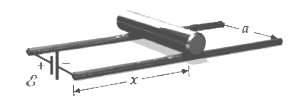A solid conducting cylinder of radius 0.1 m and mass of 4 kg rests on horizontal conducting
Question:
A solid conducting cylinder of radius 0.1 m and mass of 4 kg rests on horizontal conducting rails (Figure). The rails, separated by a distance a?= 0.4 m, have a rough surface so the cylinder rolls rather than slides. A 12-V battery is connected to the rails as shown. The only significant resistance in the circuit is the contact resistance of 6 ? between the cylinder and rails. The system is in a uniform vertical magnetic field. The cylinder is initially at rest next to the battery.
(a) What must be the magnitude and direction of B?so that the cylinder has an initial acceleration of 0.1 m/s2 to the right?
(b) Find the force on the cylinder as a function of its speed v.
(c) Find the terminal velocity of the cylinder.
(d) What is the kinetic energy of the cylinder when it has reached its terminal velocity? (Neglect the magnetic field due to the current in the battery?rails?cylinder loop and assume that the current density in the cylinder is uniform.)

Step by Step Answer:

Fundamentals of Ethics for Scientists and Engineers
ISBN: 978-0195134889
1st Edition
Authors: Edmund G. Seebauer, Robert L. Barry





